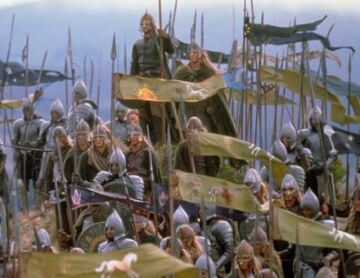Men (initially named Atani) were one of several races inhabiting Arda. They were the humans of Middle-earth, and the second of the Children of Ilúvatar; but the fourth of the Free Peoples of the World.
Origins
Mankind was created by the supreme God, Ilúvatar, awaking in Hildórien at the rising of the Sun after the Elves, Dwarves, and Ents had been made. They were called the "Afterborn" (Quenya: Atani, Sindarin: Edain) by the Elves.
Men bore the Gift of Ilúvatar, which is mortality, and therefore aged and died when their time came; and were susceptible to illness and disease. Elves, by contrast were immortal, in the sense that they are not susceptible to aging and disease; and they were tied to this world, and even remained in it after they died. However, this meant that Men were not bound to Arda as Elves were; and even the Valar did not know what ultimate fate awaited the souls of Men. Ilúvatar declared that, after the world's end, the Atani, and not Elves, would play a part in the "Second Music of the Ainur".
Nature
Eru did not make Men as similar to the Valar as He did the Elves; rather, He blessed His second children with "strange gifts". Amongst His creatures, Men alone would shape their lives beyond the music of the Ainur, to which all else was subject. Along with this gift of freedom, Men were mortal, and hence not forever bound to Arda.
Ilúvatar foretold that Men, being imperfect, would stray often and not use their gifts in harmony. However, He also noted that "These too, in their time shall find that all that they do redounds at the end only to the glory of my work."
The Elves tended to consider Men a burden to Manwë as they seemed to resemble Melkor most of all the Ainur, and, indeed, it was true that Men desired power more than any other race in Middle-earth. But, in truth, the Dark Lord feared and hated the Atani.
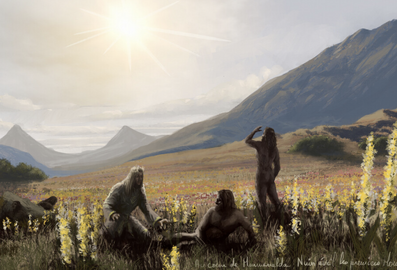
Terminology
The Elves called mankind Atani, meaning in Quenya "Second People", but also Hildor ("the Aftercomers"), Apanónar ("the Afterborn") and Fírimar ("the Mortals") or Engwar ("the sickly"). They were also called the Usurpers, the Strangers, the inscrutable, the Self-cursed, the Heavyhanded, the Nightfearers and the Children of the Sun. The name Atani became Edain in Sindarin, but this term was later applied only to those Men who were friends of the Elves in Beleriand.
In his writings, J.R.R. Tolkien uses the term Men, in place of "mankind" or "Man", to refer to human males and females collectively.
Terms used in the First Age to refer to Men who were not Edain were Rhevain and Hravani, both translating to 'the Wild'. The "Black Men" and the "Swarthy Men" (who would become known as the Haradrim and Easterlings respectively) were both held to be ethnicities of this distinction.
Groups & alignments
Though all Men of Arda were related by blood, they were sundered, and different cultures developed. The most renowned group of Men were the Edain. The word Edain refers to all Men, but the Elves used it to specify those who fought with them in the First Age against Morgoth in Beleriand.
Those Men who fought with them against Morgoth were divided into three Houses. The First House of the Edain was the House of Bëor, and entered Beleriand in FA 310, granted the fief of Ladros in Dorthonion by Finrod Felagund. The Second House, the Haladin, was led by Haldad (and later by his daughter, Haleth) who settled in the Forest of Brethil. The Third House, which became the greatest, was led by Marach and later his descendant, Hador. They settled Dor-lómin. This house was known both as the House of Marach and the House of Hador.
The Easterlings, or "Swarthy Men", sided openly with Morgoth as of FA 472; nothing is told of the forming of their culture. The descendants of the "Black Men", the Haradrim, would fight on Sauron's side millennia later against the descendants of the Edain. Other tribes of Men remained east of the Misty Mountains, apart from Beleriand, and did not engage with Morgoth. Below follow short descriptions of the most important groups of Men in the First, Second, and Third Ages.
Edain and Dúnedain
For their services and assistance to the Elves and Valar in the War of Wrath at the end of the First Age, the Edain were rewarded with a new land of their own, between Middle-earth and the Undying Lands. This was the vast island of Númenor, an island separated from the perils of Middle-earth.
The Edain were led to this island by Elros with the help of his father Eärendil, who had sailed the heavens as the bright star of the same name. Once there, Elros became first King of Númenor, as Tar-Minyatur, and the Edain became known as the Dúnedain (Sindarin for "Men of the West"). The kingdom of Númenor grew steadily in power and the Dúnedain became the noblest and highest of all Men of Arda. Allied to the Elves, Númenor fought for a time against Morgoth's lieutenant Sauron.
Now that the Men of the West had become powerful they came to resent the Gift of Men, death. They wanted to become immortal like the Elves, and enjoy their accumulated power for all time. The Númenóreans turned away from the Valar, began to call the Gift of Men the Doom of Men and cursed the Ban of the Valar which forbade them to sail west beyond sight of Númenor or to enter Valinor. In SA 2899 Ar-Adûnakhôr became the first King of Númenor who took his royal name in Adûnaic, the language of Men instead of Quenya, the language of the Elves.
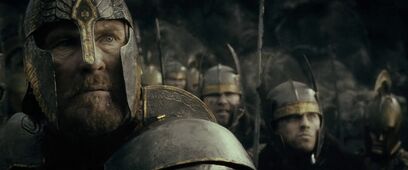
The people of Númenor thus became divided into two factions: the King's Men, who enjoyed the support of the King and the majority of the people. They favored Adûnaic as their language. The minority faction, the Faithful, were led by the Lord of Andúnië, in the west of Númenor, and favored Sindarin and friendship with the Elves. Sauron, who by the second millennium of the Second Age was nearly defeated by the Elves and Númenóreans, took advantage of the division. He surrendered to the last Númenórean King, Ar-Pharazôn, and worked his way into the king's counsels. Ultimately, Sauron advised him to attack Valinor and claim immortality. This he foolishly did, and as a punishment Númenor, the island of the Men of the West fell and only the Faithful escaped, founding the twin kingdoms of Gondor and Arnor.
Black Númenóreans and Haradrim
Before the fall of Númenor, however, as it was growing in naval power, many Númenóreans sailed east and founded colonies in Middle-earth. In the second millennium of the Second Age there was an exodus of Men from overcrowded Númenor. The King's Men migrated because they wanted to conquer more lands, and the Faithful because they were persecuted by the Kings. The Faithful settled in Pelargir and the King's Men settled in Umbar. When Númenor was destroyed the King's Men became known as the Black Númenóreans and remained hostile against the Faithful of Gondor. Some of the Nine Nazgûl were possibly recruited from their ranks. Umbar was later conquered by Gondor in TA 933.
Among the Black Númenórean race was the wicked Queen Berúthiel, wife of Tarannon Falastur, King of Gondor.
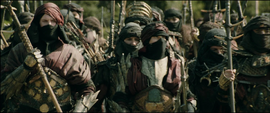
Further east of Umbar another group of Men lived, the Haradrim. They were dark skinned Men and waged war on great Oliphaunts or Mûmakil. Hostile to Gondor, they were subdued in TA 1050 by Hyarmendacil I.
Both Umbar and Harad were left unchecked by Gondor's waning power by the time of the War of the Ring, and presented grave threats from the south. Many Haradrim fought with Sauron's forces against Gondor in that War.
The Corsairs of Umbar were pirates who hailed from the havens of Umbar are were masters of the sea and ships. Although they were due to fight for Sauron in the Battle of the Pelennor Fields, they were defeated by the Army of the Dead and their ships seized by Aragorn II.
Variags came from Khand, south of Rhûn. Little is known of this people other than that they attacked Gondor in alliance with the Wainriders in TA 1944, and again as servants of Sauron in the War of the Ring.
Easterlings
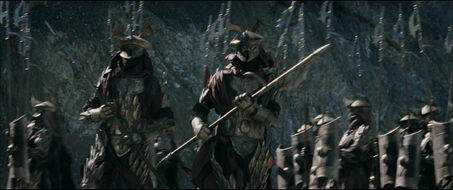
Most of the Men who fought in the armies of Morgoth and Sauron were Easterlings, who came from the region around the Sea of Rhûn. Some Easterlings offered their services to the Elvish kingdoms in Beleriand, among them were Bór and his sons and Ulfang the Black and his sons. This proved to be disastrous for the Free Peoples in the Nírnaeth Arnoediad when Ulfang and his clan switched sides and defected to Morgoth, while Bór and his sons died bravely fighting on the side of the Elves.
After Morgoth's defeat, Sauron extended his influence over the Easterlings and although Sauron was defeated by the Last Alliance of Elves and Men at the end of the Second Age, the Easterlings were the first enemies to attack Gondor again in TA 492. They were soundly defeated by King Rómendacil I, but invaded again in TA 541 and took revenge by slaying King Rómendacil. Rómendacil's son Turambar took large portions of land from them. In the next centuries Gondor held sway over the Easterlings. When Gondor's power began to decline in the nineteenth century of the Third Age, the Easterlings took the complete eastern bank of the Anduin except Ithilien, crushing Gondor's allies, the Northmen.
The Easterlings of the Third Age were divided in different tribes, such as the Wainriders and the Balchoth. The Wainriders were a confederation of Easterlings which were active between TA 1856 and TA 1944. They were a serious threat to Gondor for many years, but were utterly defeated by Eärnil II in 1944. When Gondor lost its royal dynasty in TA 2050 the Easterlings started to reorganize themselves, possibly with direction from agents of Sauron, and a fierce tribal confederacy called the Balchoth emerged. In TA 2510 they invaded Gondor again and conquered much of Calenardhon, until they were defeated by the Éothéod, coming to Gondor's aid.
Until the War of the Ring, the Easterlings didn't launch any further invasion. During the War of the Ring, they were amongst the fiercest warriors deployed at the Battle of the Pelennor Fields by Sauron and fought on even when the Battle of the Black Gate was lost, so deep was their hatred of the Men of the West.
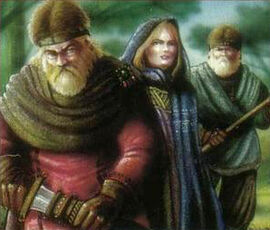
Northmen
The Northmen were composed of two principal groups. First, not all the Men who remained east of the Blue Mountains and Misty Mountains were tempted by Morgoth or Sauron. They were joined after the War of Wrath by those of the Edain who did not wish to travel to Númenór (similar to how, at the end of the first age, various Eldar remained and went east, becoming lords of the Silvan Elves). The Northmen who dwelt in Greenwood the Great and other parts of Rhovanion were friendly to the Dúnedain, being for the most part their kin, and many of them became subjects of Gondor. The Men of Dale and Esgaroth were Northmen, as were the Woodmen of Western Mirkwood, and the Éothéod, who became the Rohirrim.
Lossoth
The Lossoth were the Men of the Forodwaith. They were used to the cold of the realm of Morgoth. They were unrelated to any of the Houses of the Edain.
Dunlendings and Drúedain
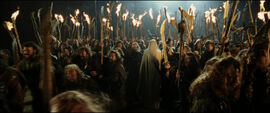
When Elendil founded the Kingdom of Arnor its borders were quickly extended towards the river Greyflood (Sindarin Gwathló), and Gondor likewise extended up through Enedwaith. In Enedwaith (Middle-land) and Minhiriath (Sindarin for Land between the Rivers) lived a group of Men related to those Men that had become the House of Haleth, and they were known as the Dunlendings. They had lived in the great woods that covered most of Eriador, and when the Númenóreans started to chop these woods down to build their ships in the Second Age, the Númenóreans earned the hostility of the Dunlendings. The Dunlendings later became bitter enemies of Rohan. The Dunlendings served Saruman in the War of the Ring and participated in the Battle of the Hornburg.
Another group of Men were the Woses or Drúedain. They were small and bent compared to other Men. The Woses had brown to black skin. They lived among the House of Haleth in the First Age, and were held as Edain by the Elves, who called them Drúedain (from Drûg, their own name for themselves, plus Edain). At the end of the Third Age some Woses lived in the Drúadan Forest, small in number but experienced in wood life. They held off Orcs with poisoned arrows and were vital in securing the aid of the Rohirrim in the Battle of the Pelennor Fields. King Elessar granted to them the Drúadan Forest "forever" in the Fourth Age.
Physical characteristics
Men were a highly varied and diverse race who came in many different forms depending on the geographical locations they dwelt in and the evolutions of their respective sub-cultures. In overall appearance they were most similar to Elves but with distinctive differences. Men possessed rounded ears and rougher features and unlike male Elves, Men could grow facial hair. In another point of contention between the two races, Men were not as physically capable as the Eldar and would tire much more quickly, no matter how fit and strong they were. Men of Númenórean descent were at a lesser disadvantage due to their heritage, but even they were inferior to the Eldar. The females of both races shared much of the same differences as their male counterparts. Men also had a passing semblance to Hobbits and Dwarves but were as a rule taller, though they had not the hardiness nor the innate skills of Dwarves.
Differing skin color, hair color, eye color, height and adaptations for geographical conditions created many varieties of Edain throughout Middle-earth; some sub-types of Men were taller than others, some were more suited to living in a jungle or arid climate, some were adapted to a sea-faring lifestyle and others had darker complexions to protect them from intense levels of sunlight.
Like Dwarves and Hobbits, Men were a diurnal race who were active during the day and slept during the night. Out of all the Free Peoples, Men were the most fecund, capable of producing plentiful offspring the quickest with Hobbits next after them, Dwarves bringing up the rear and Elves coming in last. This ability to reproduce easily and quickly gave Men a key advantage in the expansion of their dominions, military campaigns and their eventual supremacy over Middle-earth.
Notable Men
First Age
- Beren, son of Barahir
- Bëor the Old
- Haleth, daughter of Haldad
- Hador, son of Hathol
- Galdor, son of Hador
- Húrin, son of Galdor
- Túrin Turambar, son of Húrin
- Tuor, son of Huor
Second Age
- Elros Tar-Minyatur, son of Eärendil (Half-elf)
- Elendil, son of Amandil
- Isildur, son of Elendil
- Anárion, son of Elendil
- Tar-Minastir, the eleventh King of Númenor
- Ar-Pharazôn the Golden, the last King of Númenor
Third Age
- Bard the Bowman, slayer of the dragon Smaug and King of Dale
- Hyarmendacil I, son of Ciryandil, perhaps the greatest King of Gondor until Elessar
- Aragorn II, son of Arathorn II
- Denethor II, son of Ecthelion II, last of the Ruling Stewards of Gondor
- Boromir, son of Denethor II
- Faramir, son of Denethor II
- Eorl the Young, the founder of Rohan
- Théoden, son of Thengel
- Éomer, nephew and heir of Théoden, and his sister Éowyn
- Gríma Wormtongue, counsellor of Edoras
- Mouth of Sauron, Lieutenant of Barad-dûr
| Realms of Men of Middle-earth throughout the Ages | ||
|---|---|---|
| First Age | Amon Ereb • Forest of Brethil • Dor-lómin • Eriador • Estolad • Ladros | |
| Second Age | Arnor • Dunland • Gondor • Haradwaith • Númenor• Rhovanion • Rhûn • Umbar | |
| Third Age | Arnor (later split into Arthedain, Cardolan, and Rhudaur) • Dale • Dunland • Lake-town (later part of the kingdom of Dale) • Gondor • Haradwaith • Khand • Rhovanion • Rohan • Rhûn • Umbar • Vales of Anduin | |
| Fourth Age | Dale • Haradwaith • Núrn • Reunited Kingdom of Gondor and Arnor • Rhovanion • Rohan • Rhûn • Khand • Eriador • Vales of Anduin | |
|
Races of Arda
Ainur (Valar & Maiar) | Dwarves | Elves | Ents | Great Eagles | Hobbits | Huorns | Men | Petty-dwarves | Skin-changers (Beornings) Servants of the Shadow:
Barrow-wights | Ettens | Dragons (Fire-drakes & Cold-drakes) | Ogres | Orcs (Uruk-hai) | Spiders | Trolls | Úmaiar (Balrogs) | Úvanimor | Vampires | Wargs | Werewolves |
